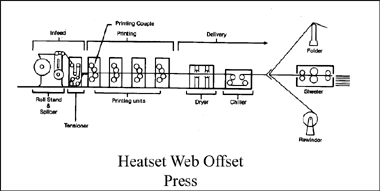A detailed description of web offset press operation is beyond the scope of this publication or training. However, the growth of web printing for books, newspapers, magazines, business forms, etc. has made the process a major part of the printing industry. The following information will give you a brief introduction and understanding of the workings of a web offset press.
Web printing refers to the printing on a continuous roll of paper (or some other substrate) rather than printing on individual sheets as a sheetfed press does. There are two basic types of web presses with two sub types. These include:
- Heatset web – heat dries the ink
- Blanket to blanket – prints both sides of the web at the same time.
- Coldset web – ink dries by air and absorption
- Blanket to impression – only prints one side at a time
The web press is similar to the sheetfed press in that it contains an infeed section, printing units and delivery section. However, because the web prints rolls the various sections are different from those used on a sheetfed press.
There are differences between the various web presses not only in web width but speed, configuration, etc. Web press widths can vary from 11″ up to 56″. Speeds can vary from 300 feet/minute to 3,000 feet/minute.There are basically two types of web presses:
High speed commercial web
- Used mostly for high volume printing such as publication, newspaper, book, advertising, etc.
- Speed: 900 – 3000 ft/min
- Heatset – ink dries by heat
- Combination sheeters and folders
- Prints both sides of the web at the same time.
- “Half-web” meaning web widths in the 25″ range
- “Full-web” meaning web widths in the range between 33″ – 56″
Small (narrow) Web
- Used mostly for lower volume printing such as business forms, small publications, etc.
- Speed: 300 – 900 ft/min
- Coldset – ink dries by air and absorption (into the paper)
- Roll to roll or roll to sheet or roll to fan-fold
- Able to perforate, punch, etc.
- Width ranges from 11″ to 25″
All web presses have some commonaities such as an infeed, printing units and delivery.

Infeed:
Paper is delivered to the press by the infeed section. The infeed section typically contains a roll stand to hold the paper rolls; a splicer which automatically splices the end of one web to the beginning of another (except on small business forms presses), a web-steering device which controls the sidelay (side-to-side position) of the infeeding web; and a tensioner that maintains the proper tension on the web as it enters the press.
Printing Units:
Web presses are made up of several printing units usually numbering from 3 up to or more than 9. Like sheetfed, each printing unit contains an inking system, a dampening system, a plate cylinder, a blanket cylinder, and an impression cylinder.
Printing Units:
Web presses are made up of several printing units usually numbering from 3 up to or more than 9. Like sheetfed, each printing unit contains an inking system, a dampening system, a plate cylinder, a blanket cylinder, and an impression cylinder.

Delivery:
The delivery section can consist of a variety of devices, from a simple sheeter, which cuts the moving web into sheets of the required size, to a combination sheeter and folder, which can both fold the web into final signatures (group of pages) and trim the signatures to size. Small business forms presses can print from a roll into another roll for future processing.
While there are similarities between the various web presses, there are also many differences.

